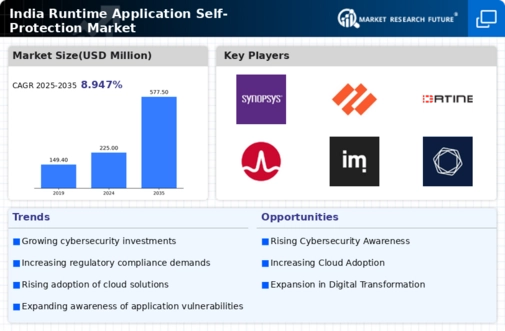Growing Regulatory Pressures
The evolving regulatory landscape in India is a crucial driver for the runtime application-self-protection market. With the introduction of stringent data protection laws, organizations are compelled to adopt comprehensive security measures to comply with regulations. The Personal Data Protection Bill, which is anticipated to be enacted soon, will impose heavy penalties for non-compliance, thereby incentivizing businesses to invest in runtime application-self-protection solutions. This market is expected to expand as companies strive to meet regulatory requirements while protecting sensitive information. The runtime application-self-protection market industry is thus likely to experience growth as organizations seek to align their security practices with legal obligations, ensuring that they avoid potential fines and reputational damage.
Rising Cybersecurity Threats
The increasing frequency and sophistication of cyberattacks in India is a primary driver for the runtime application-self-protection market. Organizations are facing threats from various sources, including ransomware, phishing, and advanced persistent threats. According to recent reports, cybercrime costs in India are projected to reach $1 trillion by 2025, highlighting the urgent need for robust security measures. As businesses recognize the potential financial and reputational damage from breaches, investment in runtime application-self-protection solutions is likely to surge. This market is expected to grow as companies seek to safeguard their applications in real-time, ensuring that vulnerabilities are mitigated before they can be exploited. The runtime application-self-protection market industry is thus positioned to benefit significantly from this escalating threat landscape.
Demand for Real-Time Security Solutions
The increasing need for real-time security solutions is significantly influencing the runtime application-self-protection market. As cyber threats evolve, traditional security measures often fall short in providing adequate protection. Organizations in India are recognizing the importance of proactive security measures that can detect and respond to threats in real-time. This shift is reflected in the growing investment in runtime application-self-protection technologies, which offer continuous monitoring and automated responses to security incidents. The runtime application-self-protection market industry is likely to benefit from this trend, as businesses seek to enhance their security posture and minimize the impact of potential breaches. The demand for such solutions is expected to rise as organizations prioritize agility and responsiveness in their security strategies.
Increased Awareness of Application Security
There is a growing awareness of the importance of application security among businesses in India, which is driving the runtime application-self-protection market. As organizations recognize that applications are often the target of cyberattacks, they are prioritizing security measures to protect their software. This heightened awareness is leading to increased investments in runtime application-self-protection technologies, which provide an additional layer of security by monitoring applications during execution. The runtime application-self-protection market industry is likely to see growth as companies seek to educate their teams and implement best practices for application security. This trend suggests a shift towards a more security-conscious culture within organizations, further propelling the demand for advanced protection solutions.
Increased Adoption of Digital Transformation
The ongoing digital transformation across various sectors in India is driving the demand for the runtime application-self-protection market. As organizations migrate to digital platforms, they are increasingly reliant on applications that handle sensitive data. This shift necessitates enhanced security measures to protect against potential vulnerabilities. A report indicates that the digital transformation market in India is expected to reach $1 trillion by 2025, with a substantial portion allocated to security solutions. Consequently, businesses are prioritizing runtime application-self-protection technologies to ensure that their applications remain secure during and after the transformation process. The runtime application-self-protection market industry is thus likely to see significant growth as companies seek to integrate security into their digital initiatives.























Leave a Comment